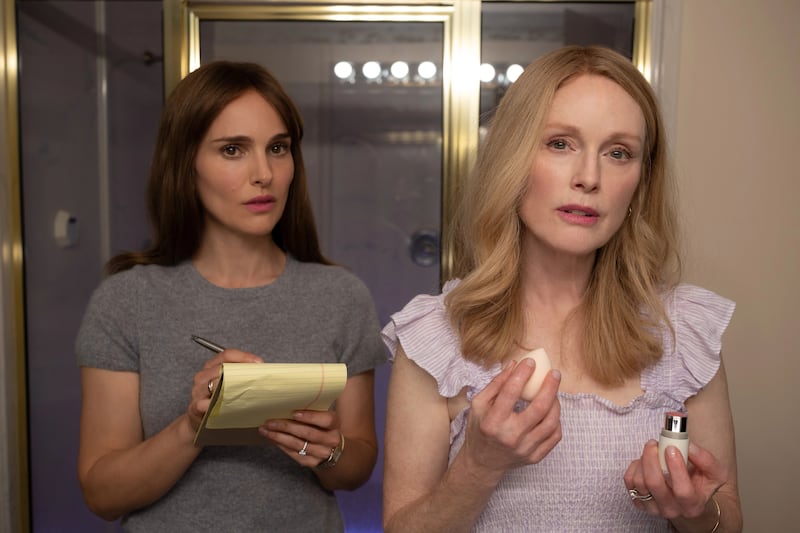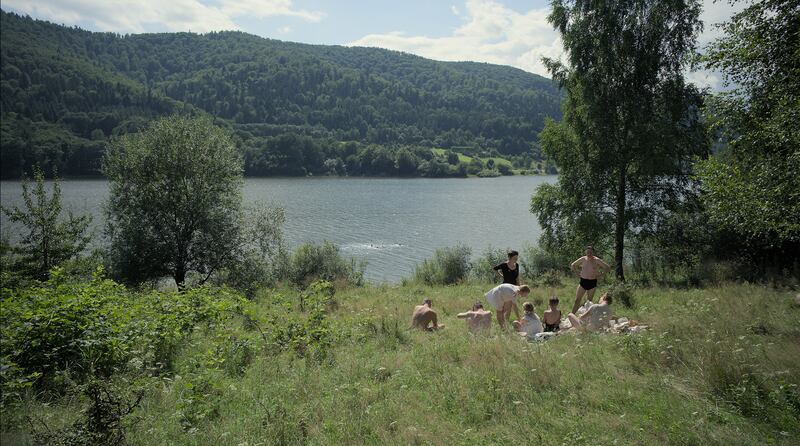“The first time I came to Cannes I was covered in bruises,” Cate Blanchett said recently. “I just came into the market with a little tiny comedy in the marketplace and as a nobody. So I was completely elbowed out of the way.”
Nobody is now elbowing Blanchett – here with Warwick Thornton’s The New Boy – but that sense of Cannes being a high-end beach brawl never quite goes away. It gets worse when it rains. The Irish Times was present at the screening of Pedro Almodóvar’s Strange Way of Life but missed the “mini riot”, as the Hollywood Reporter described it, after dozens of drenched ticket holders were denied entry. Access to the movies was an issue throughout the first week, with some press finding that, after logging on to the website at the start of booking, practically every one of the films was then unavailable. Arguments about a decline in enthusiasm for the theatrical experience feel flawed when you’re turning blue in a crush before the Claude Debussy Theatre.
No film was more in demand than Martin Scorsese’s Killers of the Flower Moon. Playing out of competition, the sprawling crime epic screened just twice (officially): a groaning red-carpet premiere overlapped with one press show. It will not open commercially for another five months. So the body cinema was furiously eager to get its first glimpse.
On balance, viewers were not disappointed. Killers of the Flower Moon is adapted from a much-admired book by David Grann, and stars Leonardo DiCaprio and Robert De Niro, Scorsese recidivists, in the grim story of how, during the 1920s, white America strove to profit off the Osage tribe’s good fortune in discovering oil on their land in Oklahoma.
New homes: comprehensive guide to what’s for sale in Dublin, Wicklow, Kildare, Meath, Cork and around the State
‘They’re supposed to represent us, not sue us’: Crafts council threatens members after critical feedback
If Robert De Niro no longer feels he is able to speak out, one wonders who in the US does
The screenplay, by Eric Roth and the director, wastes no time in confirming that the murders, bombings and mysterious fatal illnesses are the work of local boss William “King” Hale (De Niro) and his nephew Ernest Burkhart (DiCaprio). A menagerie of lesser hoodlums and psychopaths help out in murdering their way to control “headrights” on the gushing wells.
Killers of the Flower Moon, stretching close to 3½ hours, boasts the usual mass of impeccable technique from Scorsese and his team. Robbie Robertson’s throbbing score monitors the escalating menace in the first half. Rodrigo Prieto shoots the emerging communities in the sunset browns of great western oil painters. The sluggish pace of a repetitive first two hours – one damn murder after another – asks a lot of the audience’s indulgence, but, following an ingenious coda, one emerges cheered by the 80-year-old director’s continuing taste for the hunt.
The good people at Apple and Paramount will be pleased by their visit to Cannes. De Niro got to call Donald Trump “stupid” at the press conference. The red carpet was stuffed. And the reviews were almost universally laudatory.

Walt Disney, now owner of LucasFilm, will have divided feelings about its Croisette outing with James Mangold’s Indiana Jones and the Dial of Destiny. Harrison Ford’s emotional response at receiving an honorary Palme d’Or charmed everyone. The images from the red carpet were all over the media. But, just weeks before its arrival in cinemas, the critics were at best lukewarm on the fifth film in the series.
It is, for the most part, an entertaining zip through familiar pleasures. Following a long prologue featuring a convincingly deaged Ford as Indy in the closing days of the second World War, the film dumps the septuagenarian (still just, at time of filming) into New York of the late 1960s. It is hardly worth summarising the avalanche of McGuffins that takes him on a horse ride through Manhattan on to underwater adventures in the Adriatic and tuk-tuk chases in north Africa. Suffice to say there are just enough narrative tendrils to hold the collision of CGI set pieces together. Phoebe Waller-Bridge and Mads Mikkelsen offer strong support. The slam-bang ending would be less entertaining if, as is scarcely possible, it were any less absurd. It is, however, probably as well that this is the end of the line for the series.
Thierry Frémaux, the festival’s director, has said that he would have liked to have had Killers of the Flower Moon battle for the Palme d’Or. Given the response, Scorsese and Apple may regret they decided to play out of competition. Mind you, that would have left attendees facing three films in the race for the main event at well over three hours. Nuri Bilge Ceylan’s well-reviewed About Dry Grasses, about teachers in a remote corner of Anatolia, clocks in at 197 minutes. Wang Bing’s Youth (Spring) – a layered, engrossing study of textile workers in contemporary China – beats that with 212 minutes. (Inexplicably, Youth is the first formal documentary in 15 years to compete.)
But these rank as lightweight when set beside Steve McQueen’s Occupied City, playing out of competition at 262 minutes – plus intermission. Many have commented that McQueen’s film, which examines the Nazi occupation of Amsterdam with a lens pointed at the contemporary city, plays like one of the gallery-based pieces with which the director made his name, but the cumulative effect of catching it in one lump is extraordinary.
So what of the competition so far? For this writer, two films stand above the otherwise respectable rest. That following peloton includes Monster, a worthwhile but not top-drawer new film from the 2018 Palme d’Or winner, Hirokazu Koreeda. The Japanese director shows his gifts for working with children in a drama that examines a mother’s concerns about an apparently bullied son. The acting is strong. The lacustrine ambience is evocative. A final score from the late Ryuichi Sakamoto is beautiful. But the screenplay by Yuji Sakamoto is too convoluted for its own good.
Also in competition is Jean-Stéphane Sauvaire’s operatically miserable Black Flies. Sean Penn and Tye Sheridan star as old-hand and rookie paramedics cleaning the dangerous streets of New York. Thoughts of Scorsese’s Bringing Out the Dead are unavoidable, but this (literally) Wagnerian indulgence beats that film flat for pestilent despair. More impressive are Ramata-Toulaye Sy’s debut feature, Banel & Adama, a folk tale from Senegal, and Kaouther Ben Hania’s Four Daughters, a clever metamovie investigating a scandalous family story from Tunisia.

But the contenders for this paper’s private Palme come, so far from, an American veteran and a British director who has gradually come to challenge for best of his generation. Todd Haynes, director of Carol and Far from Heaven, returns to the testy sexual dynamics of his early work with the delightfully odd drama – or maybe comedy – May December. Natalie Portman plays an actor visiting a couple, notorious decades earlier, as she researches a film on their story. We soon learn that Gracie (Julianne Moore) became involved with Joe (Charles Melton) when she was in her 30s and he was just 13. They now appear to be happily married, with college-age children. Nodding towards Ingmar Bergman’s Persona, featuring a telling musical borrow from Michel Legrand’s score for The Go-Between, May December relishes the stripping-away of facades to reveal self-deception in every corner. Working from a script by Samy Burch, Haynes again reveals his gift for finding rippling unease beneath surface beauty.
The best film yet screened in the competition is Jonathan Glazer’s The Zone of Interest. Little production information emerged during the shooting of Glazer’s loose (very loose) adaptation of Martin Amis’s novel about the unconcerned lives of the commandant of Auschwitz and his bourgeois family as the camp ramps up its regime of annihilation. Glazer, director of three highly admired films – Sexy Beast, Birth and Under the Skin – excels again with a film that eerily sets the carnage at a remove throughout.

Keeping his cameras at a distance, he follows Rudolf Höss and his wife, Hedwig, as they welcome guests, squabble about possible reassignment and otherwise go about their quotidian business. Sandra Hüller is snappy as Hedwig. Christian Friedel is prissy as Höss. Glazer’s genius is to keep the horror at just the penumbra of consciousness. The noise of destruction is near-ambient throughout – machine crunch, rifle pops, distant screams. One senses almost every reviewer trying to resist Hannah Arendt’s “banality of evil”, but no film has better addressed that concept.
It thus seems like an odds-on contender for the Palme d’Or (which, on previous experience, means it has no chance of winning). Hüller will recall being in the same position with the equally raved about Toni Erdmann, a film that ended up taking nothing. The team’s content at the positive reception will, no doubt, have been tempered by the death of Martin Amis just a day after the premiere. It is bitter to relate that Glazer’s film is by far the best adaptation of the now-late English writer’s work.
The 76th Cannes film festival continues. Titles from the likes of Aki Kaurismäki, Ken Loach and Wim Wenders will premiere in competition over the coming week before the presentation of the Palme d’Or on Saturday May 27th.



















